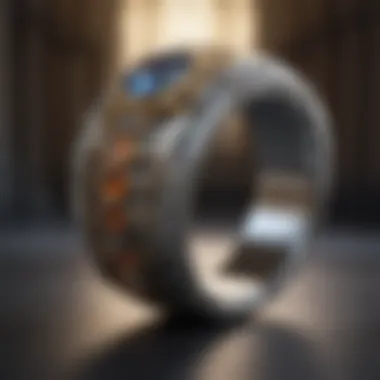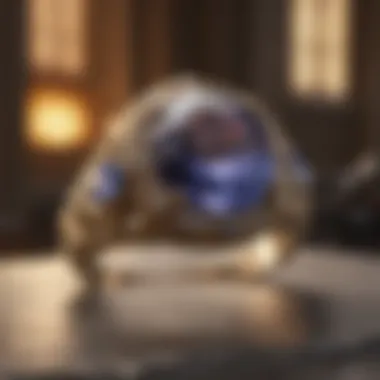Exploring Cathedral Design in Gemstone Rings


Intro
In the realm of jewelry design, cathedral rings stand out as a potent expression of both artistry and heritage. Their unique structure, characterized by arches that resemble the grand ceilings of medieval cathedrals, embodies a rich tradition intertwined with profound meaning. This section delves into the roots of gemstone selection, formation, and the deep cultural connections that underpin their significance.
Overview of Gemstones and Minerals
Understanding cathedral rings requires a look at the very essence of the gems they hold. Gemstones have captured human imagination for centuries, serving not only as adornments but also carrying historical and cultural significance.
History of Gemstone and Mineral Use
From the dawn of civilization, gemstones have held a pivotal place in human history. Ancient Egyptians adorned themselves with lapis lazuli, believing it offered protection from harm. The Romans used emeralds to signify status, while jade was revered in Chinese culture for its connection to immortality.
Significance in Culture and Society
The cultural relevance of gemstones extends beyond their aesthetic appeal. Consider the diamond, often associated with love and eternity. In different cultures, various gems symbolize diverse emotions. Rubies resonate with passion, while sapphires invoke loyalty. Understanding these connections enriches the experience of wearing a cathedral ring.
Gemstone Formation and Properties
Delving deeper into gemstones, one must recognize the processes that transform raw minerals into the radiant jewels we cherish.
Formation Process of Gemstones
Gemstones are formed under conditions of heat and pressure deep within the Earth’s crust. For instance, diamonds are born from carbon that has been subjected to intense heat, while sapphires and rubies originate from corundum minerals subjected to similar conditions. The geological timeline of these formations can span millions of years, resulting in stunningly unique characteristics.
Properties that Define Gemstones
Each gemstone boasts distinctive properties:
- Color: This defines the gem’s visual appeal.
- Hardness: Measured on the Mohs scale, it determines durability.
- Luster: The way light interacts with the gem.
These properties are essential, especially in cathedral design, as they dictate both the gem’s practicality and its aesthetic contribution.
Classification based on Color, Hardness, and Luster
Gemstones can be classified based on their color spectrum, ranging from the vibrant hues of rubies to the calming blues of aquamarine. Hardness varies; diamonds are on the higher end, while softer stones like pearls require careful treatment. Luster can range from glassy to pearly, affecting their desirability in design.
Types of Gemstones
In the world of rings, knowing the types of gemstones plays a crucial role in selection.
Precious vs. Semi-Precious Gemstones
Traditionally, precious gemstones include diamonds, rubies, sapphires, and emeralds. Semi-precious stones, including amethysts and garnets, offer unique characteristics and can often provide an equally striking aesthetic.
Common Gemstone Varieties
Popular varieties found in cathedral settings often include:
- Diamonds: The classic choice, unmatched in brilliance.
- Sapphires: Available in various colors, versatile for many tastes.
- Emeralds: Known for their rich green hue, they invoke royalty.
Exotic and Rare Gemstones
For those with a penchant for the unique, options like tanzanite and alexandrite can make stunning choices. These gems are not only rare but also carry their own stories, perfectly complementing the cathedral design.
Identifying and Evaluating Gemstones
The allure of a cathedral ring can often be influenced by the quality of its gemstone. Thus, identifying and evaluating is paramount.
Factors Affecting Gemstone Value
Value is determined by several factors, such as:
- Carat weight: Heaviness leads to higher prices.
- Color quality: Vivid hues are generally more valuable.
- Clarity: Fewer inclusions indicate greater value.
Techniques for Gemstone Identification
Gemstone identification can be carried out through various methods, including:
- Visual inspection: Observing internal features and surface quality.
- Refractive index measurement: To determine the light bending properties.
Assessing Gemstone Quality
To ensure a quality gemstone, one must evaluate all factors including fire, brilliance, and scintillation.
Caring for Gemstones
Once you possess these treasures, caring for them becomes essential.


Cleaning and Storing Gemstones Properly
Regular cleaning with mild soap and warm water is often sufficient. Storing them separately, preferably in soft pouches, helps to avoid scratches.
Avoiding Common Mistakes in Gemstone Care
Avoid exposing gemstones to harsh chemicals, as they can ruin their integrity. Also, refrain from using ultrasonic cleaners, especially for softer stones.
Preservation Tips for Specific Gem Types
Different gems require specific care; for instance, opals are sensitive to drying, so keeping them slightly moist can be beneficial.
In the end, understanding gemstones’ past, properties, and the artistry of cathedral designs is essential to appreciate the beauty of these exquisite rings. Mastery over their care ensures longevity for generations.
Prolusion to Cathedral Design
Cathedral design in ring settings stands as a testament to the intersection of art and emotion. It serves not just as a functional aspect of jewelry, but also as a deep expression of individual stories and significances. Understanding the essence of cathedral design opens up a world where each ring embodies meanings, memories, and celebrations. Unlike other styles, cathedral rings elevate the gemstone, offering a striking visual appeal that captivates both the eye and the heart.
Historical Overview
The concept of cathedral design has roots tracing back centuries, showcasing a fascinating evolution aligned with architectural styles. The term "cathedral" itself originates from grand cathedrals, symbolizing sacred spaces filled with light and inspiration. In jewelry design, this reflects a unique vertical setting that raises the gemstones, allowing maximum light to interact with them, just like the lofty ceilings of historical churches.
The earliest examples emerged when jewelers sought to combine beauty with functionality. The high settings became fashionable during the Victorian era. As taste shifted through the 20th century, cathedral designs adapted, integrating artistic elements influenced by design movements like Art Deco and Mid-Century styles. Notably, the intricate details of this design often draw parallels to the lavish ornamentation found in Gothic architecture, with pointed arches and intricate stonework serving as an inspiration for intricate band designs.
Relationship to Architecture
The relationship between cathedral design in rings and architecture is anything but coincidental. Inspired by magnificent structures, cathedral rings carry a sense of elegance and grace.
- Vertical Settings: Just as cathedrals use height to draw the eye upwards, cathedral rings employ elevated settings to enhance the stone's brilliance. This architectural cue provides not only aesthetic appeal but also emphasizes the significance of the gemstone.
- Structural Integrity: The design reflects the principles of statics and balance similar to architectural forms. This implies that the ring's structure not only supports the gemstone but also aligns it beautifully with the wearer's fingers.
- Symbolic Representation: Just as cathedrals serve as gathering places for the community, cathedral rings symbolize personal milestones and the congregation of emotions, invoking nostalgia and meaning in various life stages, from engagements to anniversaries.
The compelling connection between cathedral rings and architectural design lends itself to a rich narrative, where each piece tells a story rooted in history, artistry, and emotional depth. With such profound significance, it's no wonder that jewelry aficionados increasingly find themselves drawn to the charms of cathedral design.
Defining Cathedral Rings
Understanding what cathedral rings signify is crucial in appreciating their artistry. At the intersection of design and emotion, cathedral rings stand out not only for their visual appeal but also for the sentiments they hold. These rings are characterized by settings that elevate the gemstone, akin to how a cathedral uplifts the spirit of those who enter. The design allows light to flow through, enhancing the stone's brilliance and creating a captivating interplay of reflections. They serve as a testament to the meticulous craftsmanship that goes into producing unique pieces of jewelry that resonate with the wearers.
Characteristics of Cathedral Design
A cathedral ring typically showcases several defining features:
- Elevated Setting: The hallmark of cathedral design is its elevated setting. This design positions the gemstone in a way that it captures light from various angles. Such elevation not only showcases the brilliance of the gemstone but also provides a visual space that enhances the overall aesthetic appeal of the ring.
- Side Stones: Many cathedral rings incorporate smaller gemstones or diamond accents on either side of the central stone. This creates a cascading effect that mimics the architectural arches of cathedrals, lending a sense of sophistication and grandeur to the overall design.
- Intricate Detailing: The detailing in cathedral rings often resembles the ornate designs found in gothic architecture. Whether through filigree work, engraving, or the use of milgrain edges, these rings often tell a story with their intricate designs.
This type of design speaks volumes about the wearer, often embodying their values, aspirations, and connection to the beauty of craftsmanship. For gemstone enthusiasts and collectors, the significance of these elements cannot be understated.
Common Materials Used
The materials that make up cathedral rings play a crucial role in their overall design and appeal. Commonly used materials include:
- Gold: Available in various colors such as yellow, white, and rose, gold is often the primary metal used in cathedral rings. Each type offers a unique aesthetic, making it adaptable to personal style preferences.
- Platinum: Known for its durability and resistance to tarnishing, platinum provides a luxurious touch. Its weight and subtle sheen give cathedral designs a structured feel, making it a popular choice for statement pieces.
- Silver: Although less common in high-end pieces, silver can be found in more affordable cathedral rings. Its reflective quality can brighten a design without overshadowing the centerpiece gemstone.
- Gemstones: The centerpiece is typically a focal gemstone, such as a diamond, sapphire, or emerald. The choice of stone can affect the overall tone of the ring, with lighter stones offering a delicate feel, while richer tones like deep blue sapphires make a bolder statement.
By understanding these characteristics and materials, enthusiasts can appreciate the complexity behind cathedral ring designs. They are not mere accessories but pieces of art that meld tradition with personal expression.
The Symbolism Behind Cathedral Rings
Cathedral rings are not just pieces of jewelry; they are emblems of deeper meanings that resonate with their wearers. The design draws parallels to the grand architecture of cathedrals, which have been symbols of faith, community, and craftsmanship throughout history. The intricate details and lofty designs found in cathedral rings reflect not only aesthetic values but also cultural narratives that have developed over centuries. By examining the symbolism embedded in these rings, we can appreciate their role beyond mere adornment and recognize how they encapsulate emotional and cultural layers.
Emotional Significance
When one thinks of a cathedral ring, it often evokes imagery of strength, beauty, and timelessness. These rings frequently symbolize commitment and love, making them a popular choice for engagement and wedding bands.
The elevated stones set within cathedral designs suggest a form of reverence, much like the way soaring cathedral ceilings uplift the spirit. Each gem set high in the design conveys a sense of importance, resembling a beacon of light in a spiritual sanctuary. This positioning can stir emotions in the wearer, creating a personal connection to the ring that transcends material value.
Moreover, the design itself can inspire feelings of security and stability, much as the architecture of cathedrals does for those within its walls. The thoughtful craftsmanship embodied in every aspect of cathedral rings often leads wearers to perceive them as lasting legacies—pieces to be handed down through generations, solidifying bonds within families.
"Jewelry is not just about what it looks like; it's about what it means to the person wearing it. Cathedral rings have a unique ability to tell a story that spans generations."
Cultural Interpretations
The symbolism of cathedral rings often varies across cultural contexts, lending to rich interpretative histories. In some traditions, these rings are thought to represent protection and guidance, akin to the way a cathedral serves as a community's shelter. For instance, in many European cultures, a ring with such a design may be seen as a good luck charm, thought to bring prosperity and harmony into the wearer's life.
In contrast, among various indigenous cultures, cathedral rings could symbolize the connection to the earth and celestial realms. The gemstones incorporated into the design carry their own meanings—like sapphires symbolizing wisdom and strength or emeralds representing rebirth and love. This cultural significance allows cathedral rings to serve as a canvas for individual narratives, embodying one's personal beliefs, heritage, and aspirations.
As society evolves, new interpretations are cropping up. Some modern perspectives view cathedral rings as a fusion of tradition and innovation, where contemporary creatives reinterpret the classic designs to bring fresh narratives into the mix.
In summary, the symbolism behind cathedral rings stretches deep into human emotions and cultural evolutions. They are more than accessories; they are rich artifacts that weave together histories and stories, resonating with their wearers on many levels.
Different Styles of Cathedral Rings


Cathedral rings, with their graceful arches and unique settings, are not just pieces of jewelry; they speak volumes about artistry and sentiment. This section dives into the varied styles of cathedral rings, highlighting their significance and choice complexity. Each style offers different aesthetics and emotions, allowing gemstone enthusiasts to find the perfect piece that resonates with them. Knowing the distinction helps in selecting a ring that fits one's personality and occasion.
Classic Styles
The classic styles of cathedral rings maintain an enduring appeal. These designs typically feature a minimalist approach, focusing on the natural beauty of the gemstone while providing a structural elegance that stands the test of time. The ring often has elevated settings that allow light to illuminate the stone from multiple angles. This creates a stunning visual impact.
- Traditional Cathedral Setting: The setting is characterized by tall arches that rise above the center stone, akin to the ceilings of Gothic cathedrals. This style not only enhances the brilliance of the gemstone but also makes it the focal point of the ring.
- Halo Designs: Often seen as the cherry on top, halo-style cathedral rings surround the primary gemstone with smaller stones that enhance its spark and allure. This is perfect for those who appreciate an extra touch of dazzle around their main stone.
These classic styles embody timeless elegance and are perfect for various occasions, making them a cherished choice for engagement rings or special presents. Their inherent simplicity carries beauty without overpowering.
Modern Interpretations
Modern takes on cathedral rings incorporate innovative designs and materials that push the boundaries of traditional crafting. Jewelers are now mixing various art styles and trends, offering unique solutions that cater to a contemporary audience.
- Geometric Elements: Some modern interpretations feature geometric shapes and unexpected angles. The symmetrical lines provide a sleek contrast to the organic curves often found in classic cathedral designs. This adds an intriguing flair to the ring that appeals to style-savvy individuals.
- Mixed Materials: Designers are increasingly experimenting with alternative metals and materials, such as tungsten or carbon fiber, that resonate with the modern lifestyle. This not only diversifies the options but also reflects personal style statements.
With these modern styles, wearers can blend traditional cathedral aesthetics with a contemporary twist, allowing for personal expression and unique distinction.
Custom Designs
Custom-designed cathedral rings offer the ultimate personal touch. This style allows gemstone collectors to work closely with designers to create a piece that embodies their unique vision.
- Tailored Features: Customization can encompass everything from choosing the gemstone shape to selecting specific metals or engravings. Each detail, from the width of the band to the intricacies of the setting, can be tailored to individual tastes, ensuring a one-of-a-kind piece that tells a personal story.
- Incorporation of Symbols: Many people wish to imbue their rings with personal significance. Custom designs can allow for the addition of motifs or symbols that carry meaning for the wearer, be it initials, dates, or cultural symbols.
This approach not only results in an exclusive piece but also creates a deep emotional connection, enhancing the sentimental value of the ring.
"When it comes to jewelry, the value lies not only in the materials but also in the stories they tell."
Through these different styles, cathedral rings can cater to a broad audience—from traditionalists looking for timeless elegance to trendsetters aiming for modern sophistication. Understanding these options can guide anyone searching for a piece that aligns with their style and sentiment, making the process more rewarding.
The Craftsmanship of Cathedral Rings
The craftsmanship involved in cathedral rings is not just a reflection of skill but also a manifestation of passion and artistry. These rings, characterized by their elevated settings and intricate designs, require meticulous precision and a keen eye for detail. Each piece is a unique blend of traditional techniques and modern innovations, which together create a stunning aesthetic that speaks to both history and contemporary tastes.
The significance of craftsmanship in cathedral rings cannot be overstated. It directly affects the quality, durability, and overall appearance of each piece. High-quality craftsmanship ensures that the gemstones are securely held in place, enhancing their brilliance while preserving their integrity over time. Moreover, the complexity of designs allows jewelers to push the boundaries of creativity, inviting them to explore unique styles that resonate with individuality.
Techniques Involved in Creation
Creating cathedral rings involves several specialized techniques, each contributing to the final product's beauty and durability. Some prominent methods include:
- Metalworking: Jewelers often use gold, platinum, or silver as the base metal. Skilled artisans shape and mold these materials into the desired form, ensuring a perfect fit for the gemstones.
- Stone Setting: This is crucial for cathedral rings. A well-executed setting technique, like prong or bezel setting, enhances the gemstone’s exposure to light, highlighting its natural beauty while ensuring it remains secure.
- Engraving: Custom engravings can be added to personalize the ring, making it more meaningful for the wearer. Artisans weave intricate patterns or initials, which add a personal touch to the piece.
- Finishing: The final polishing and finishing touches are essential to deliver a smooth, reflective surface. This step not only enhances appearance but also protects the ring from scratches and tarnishing.
As a combined effort of these techniques, cathedral rings emerge not just as accessories but as pieces of art, each telling its own story.
Role of Gemstones in Design
Gemstones play a pivotal role in cathedral ring design, acting as the focal points around which the entire piece is built. Their significance goes beyond aesthetics; they carry emotional weight and cultural meanings. Here’s how gemstones enhance cathedral rings:
- Variety of Choices: From classic diamonds to vibrant sapphires and emeralds, the choice of gemstones can dramatically alter the ring's character. The selection often reflects the wearer's taste or purpose, whether it be a celebratory occasion or a statement piece.
- Symbolic Meanings: Different gemstones hold various meanings and properties. For example, a sapphire may symbolize wisdom and nobility, while an amethyst is often associated with peace and clarity. Choosing a gemstone with personal significance adds depth to the relationship between the wearer and the jewelry.
- Optical Performance: The way light interacts with gemstones is a critical aspect. Well-cut stones catch light beautifully and can enhance the overall sparkle of the ring. Brilliant cuts or custom faceting can further emphasize the cathedral setting’s height, allowing more light to enter and reflect out.
In essence, gemstones not only elevate the visual appeal of cathedral rings but also imbue them with stories waiting to be told. Their role is integral in creating a piece that serves as a cherished heirloom, merging artistry with personal significance.
Maintaining Cathedral Rings
Keeping cathedral rings in top shape isn't just about aesthetics; it’s about preserving their story and significance. These rings often bear deep personal meaning, tying back to cherished memories or milestones. When you maintain their luster and integrity, you're honoring that connection. But beyond emotional ties, there are practical reasons to prioritize care for these intricate pieces.
Significance of Maintaining Cathedral Rings
- Preservation of Craftsmanship: Cathedral rings, with their intricate designs and often delicate settings, require regular attention. Neglecting maintenance may lead to deterioration of both the ring and its gemstones.
- Investment Protection: For collectors and enthusiasts, cathedral rings can be substantial investments. Proper maintenance safeguards these investments from wear and tear and potential loss in value.
- Enhanced Wearability: Keeping a ring clean and in good condition ensures it remains comfortable and safe to wear.
Cleaning Techniques
Cleaning cathedral rings does not have to be a cumbersome task. In fact, with the right methods, it can be a fulfilling ritual. To keep your ring looking pristine, consider these steps:
- Use Mild Soap and Water: Mix a few drops of mild dish soap in warm water. Soak your ring for a few minutes. The warmth helps loosen stubborn grime.
- Soft Brushes: Utilize a soft toothbrush to gently scrub under the stones and in crevices. This helps to eliminate dirt without scratching the surface.
- Rinse Thoroughly: Make sure to rinse the ring under warm water, removing all soap residue.
- Dry Carefully: Let it air dry or pat it down with a soft, lint-free cloth. Avoid paper towels as they can scratch.
- Frequency: Regular cleaning every couple of weeks ensures that dirt doesn’t build up.
Note: Avoid harsher brushes which can cause damage to both the metal and gemstones.
When to Seek Professional Care
While routine cleaning can be managed at home, there are times when professional intervention is a must. Understanding when to take this step will save you from potentially costly repairs later.
- Loose Stones: If you notice any of your gemstones wobbling or not sitting snugly, it’s time to consult an expert.
- Scratches or Damage: Professional jewelers can buff out minor scratches and repair any visible damage, restoring your ring’s original beauty.
- General Check-Ups: It’s wise to have your cathedral ring examined by a professional at least once a year to catch any issues early.
- Custom Considerations: If your ring has unique design elements or rare materials, a jeweler specialized in cathedral settings is best equipped to handle it properly.
Ensuring the longevity and beauty of cathedral rings requires consistent care and occasional professional guidance. By following these practices, you will not only maintain the physical condition of your rings but also honor the emotional and artistic significance behind them.
Cathedral Design in Contemporary Jewelry Trends


In the world of gemstone jewelry, cathedral design has carved out a niche that resonates deeply with both collectors and designers alike. This design approach has evolved over time, woven into the fabric of modern aesthetics and craftsmanship. The significance of cathedral design today lies in how it unites tradition with contemporary tastes, offering a blend of durability and beauty. For those mindful of trends, understanding the nuances of this design can inform choices in collections or custom creations.
Popularity Among Gemstone Collectors
Gemstone collectors often find themselves enamored with cathedral rings due, in part, to their striking silhouette and enhanced gemstone visibility. Cathedral settings raise the gemstone above the band, allowing light to travel through the stone from multiple angles. This is particularly appealing for collectors who wish to showcase unique cuts or unusual colors. Think of it as a spotlight that captures the essence of the gemstone, allowing its true beauty to shine through.
Some points that highlight why gemstone enthusiasts gravitate towards cathedral designs include:
- Visual Appeal: The elevated position of the gemstones creates a dramatic effect, making ordinary stones look extraordinary.
- Stability and Protection: The side-supporting prongs cradle the stone effectively, reducing the risk of damage while retaining elegance.
- Customization Potential: Every collector has a unique style, and cathedral rings allow for an extensive range of personalization options, from metal choice to gemstone settings.
"Cathedral rings are not just jewelry but storytelling pieces reflecting personal journeys and aesthetic sensibilities."
Emerging Trends in Design
As the jewelry market continues to evolve, so do the trends within cathedral design. Contemporary designers are pushing boundaries, incorporating innovative materials and styles that speak to modern sensibilities. The shift towards sustainability has encouraged the use of ethically sourced gemstones and recycled metals, further increasing the appeal among eco-conscious collectors.
Some noteworthy trends are:
- Mixed Materials: Combining metals like rose gold with white gold or other elements creates striking contrasts that enhance the overall look.
- Unique Gemstone Choices: Beyond traditional diamonds, many collections now feature gemstones like morganite, sapphires, or even lab-created stones, appealing to those in search of something different.
- Minimalist Yet Bold: Less is often more; designs have become sleek, emphasizing the natural beauty of the stones, allowing collectors to express a more understated style.
By understanding these trends, collectors and enthusiasts can stay ahead of the game, ensuring their choices not only reflect their personal tastes but also remain aligned with current market movements.
Exploring Unique Gemstones for Cathedral Rings
When we think about cathedral rings, the first thing that usually pops into our minds is the design of the setting itself. However, the gemstones that adorn these rings are equally significant and can completely transform the overall aesthetic, lending personal meaning to each piece. As one dives into the exploration of unique gemstones for cathedral rings, it becomes evident that the selection goes far beyond mere appearance. It encompasses emotional connections, cultural considerations, and a reflection of individual identity.
The world of unique gemstones is vast, providing countless choices for those who seek to express their individuality through jewelry. From vibrant and playful choices to deep and somber stones, each gem comes with its own narrative, which can resonate deeply with the wearer. As we venture into the realm of popular and rare gemstones, let us examine how these selections influence both the aesthetics and symbolism of cathedral rings.
Popular Gemstone Choices
Some gemstones have maintained their popularity over the years, and for good reason. They combine beauty with symbolic representations that resonate with many:
- Diamonds: Known for their unmatched brilliance, diamonds are not just a symbol of love and strength; they have also been the go-to choice for engagement rings for decades. Their timeless appeal ensures that a cathedral ring set with diamonds will be cherished through generations.
- Sapphires: A favorite among royalty, sapphires come in a variety of colors, though the deep blue hue is the most recognized. Many believe they bring wisdom, loyalty, and nobility, making them a classic choice for special occasions.
- Emeralds: Valued for their rich green color, emeralds are often associated with rebirth and love. They have a way of drawing attention and making a statement in a cathedral ring setting.
- Rubies: Often symbolizing passion and courage, rubies are adored for their vibrant red tones. Their rarity only adds to their allure, making them perfect for those seeking uniqueness.
These popular gemstone choices each share a connection to the past while embodying personal significance in the present, serving as timeless reminders of what matters to the wearer.
Rare Gemstones and Their Appeal
On the flip side, selecting rare gemstones can set a cathedral ring apart, offering a sense of exclusivity and uniqueness. Rare stones can evoke curiosity and admiration, making them a talking point in any setting. Some noteworthy options include:
- Paraíba Tourmaline: This vivid stone, known for its electric blue and green shades, is a showstopper. Its rarity is augmented by its unique coloration, which is attributed to the presence of copper in its composition.
- Alexandrite: Known for its color-changing abilities, this stone can appear green in daylight and red in incandescent light. Its fascinating properties make it a mesmerizing choice for cathedral rings.
- Tanzanite: This beautiful blue-violet stone is found only in Tanzania and is a relatively recent discovery in the gem world. Its rarity adds to its appeal, and it’s becoming an increasingly popular choice in fine jewelry.
- Benitoite: Blue and rare, Benitoite is an even rarer gem than diamonds. It’s unique in appearance, often showing a stunning blue color that has left gem collectors enthralled.
The journey of selecting gemstones for cathedral rings is not just about their visual aspects. It's about weaving stories through these stones—stories of love, passion, history, and personal journey. Setting unique gemstones into cathedral designs can amplify that narrative, creating a piece of jewelry that resonates on multiple levels.
"Each gemstone tells a story; together, in cathedral rings, they create a narrative timeless and profound."
As gemstone enthusiasts, collectors, and jewelry designers scour the market for the next unique stone to incorporate into their designs, we find that the significance of these gems runs deeper than specifications or monetary value. The evolution of gemstone selection reflects changes in personal expression, cultural trends, and the ongoing quest for originality in the world of jewelry.
The Future of Cathedral Design in Rings
The realm of cathedral design in rings is at an intriguing crossroads, where tradition meets innovation, pushing the boundaries of jewelry craftsmanship. As a reflection of deeper cultural shifts and the evolving priorities of consumers, this future holds immense significance for both designers and enthusiasts. There are a few key points to consider, such as the increasing demand for sustainability, the impact of emerging technology, and the synergy between emotional resonance and modern aesthetics.
Sustainable Practices in Jewelry
In recent years, sustainability has moved from a buzzword to a core principle driving many industries, jewelry included. As gemstone enthusiasts and designers increasingly prioritize ethical sourcing, the concept of sustainable practices has taken hold in cathedral designs. This focus isn't merely a trend; it's essential for the integrity of the craft.
- Ethical Sourcing: Designers are now opting for gemstones that are sourced responsibly. For example, fair trade diamonds or lab-grown alternatives have gained traction, ensuring that environmental and ethical standards are met without compromising quality.
- Recycled Materials: Using reclaimed metals and materials in the creation of cathedral rings mirrors an eco-conscious mindset. This choice reduces waste and acknowledges the lifecycle of materials, providing an opportunity to create something beautiful with a lesser environmental footprint.
- Transparent Supply Chains: As consumers grow more discerning, they seek transparency in the source of their jewelry. The future of cathedral design will likely see many brands implementing systems that clearly delineate their supply chains. This will not only bolster consumer trust but elevate brands that prioritize responsible practices.
Adopting sustainable practices not only impacts the environment positively, but it also becomes an integral part of the story behind each piece, fostering a deeper connection between the wearer and the ring.
Advancements in Technology
As technology continuously evolves, its influence permeates every aspect of jewelry design, enhancing the way cathedral rings are crafted and perceived. The incorporation of cutting-edge technological advancements leads to heightened creativity and improved craftsmanship, allowing artisans to push boundaries in ways previously thought impossible.
- Computer-Aided Design (CAD): CAD programs have revolutionized design processes. Jewelers can now create intricate designs with precise measurements, allowing for greater detail in cathedral settings. This precision translates into a quality product that can be replicated across a variety of designs.
- 3D Printing: The advent of 3D printing technology permits faster prototyping and greater complexity in designs. It offers jewelers the freedom to experiment with forms and structures, bringing fresh perspectives to traditional cathedral settings.
- Augmented Reality (AR): To enhance customer experience, many jewelers are utilizing AR technology. Customers can view rings in a virtual environment, helping them visualize the piece before purchase. This innovative approach not only boosts customer confidence but enhances engagement in the shopping experience.
The marriage of technology and craftsmanship is reshaping the future of cathedral design, allowing artisans to create intricate rings that resonate with contemporary values and aesthetics.
As we look ahead, cathedral designs in rings will not only reflect aesthetic value but will carry stories of sustainability and innovation, ensuring that each piece continues to resonate on emotional and cultural levels. This intersection of past traditions and future innovations will continue to engage and educate both designers and collectors alike.
Epilogue
In wrapping up our exploration of cathedral design in rings, it's crucial to reflect on the significance of this intricate subject. Cathedral rings aren't just pieces of jewelry; they embody a blend of artistry and emotion that resonates deeply with both designers and wearers. Every curve and contour speaks to a narrative that elevates the piece beyond mere aesthetics.
Summing Up Cathedral Design
The architectural inspiration behind cathedral rings reflects centuries of tradition and innovation. Their elevated settings, which mimic the towering arches of cathedrals, allow gemstones to shine brightly, capturing light in a way that standard designs often fail to match. This design choice not only enhances the visual appeal but also imparts a sense of sanctuary, enveloping the gemstone in a protective embrace. As we consider their history, one must not overlook the cultural impact these rings have had across diverse societies. In numerous cultures, the symbolism associated with cathedrals—representing faith, permanence, and beauty—transfers seamlessly into the realm of jewelry, thereby creating profound connections between people and their adornments.
Encouraging Exploration of Gemstone Jewelry
As we delve deeper into the world of cathedral rings, there's a compelling invitation for gemstone enthusiasts and collectors alike to keep exploring. The market for unique gemstones continues to expand, revealing not only rare finds but also fostering a conversation around sustainability and ethical sourcing. Each stone tells a story, and when mounted in a cathedral setting, those stories often resonate louder. Individuals contemplating a purchase can consider local artisans or design their rings, creating personalized connections to their jewelry. Beyond aesthetics, the emotional weight carried by these pieces promotes an appreciation for craftsmanship. By connecting with designers or even learning about personalization options, collectors can further enrich their experience and embody a piece of history on their fingers.
"The magic of cathedral rings lies not just in their beauty but also in the stories they tell and the emotions they evoke."







